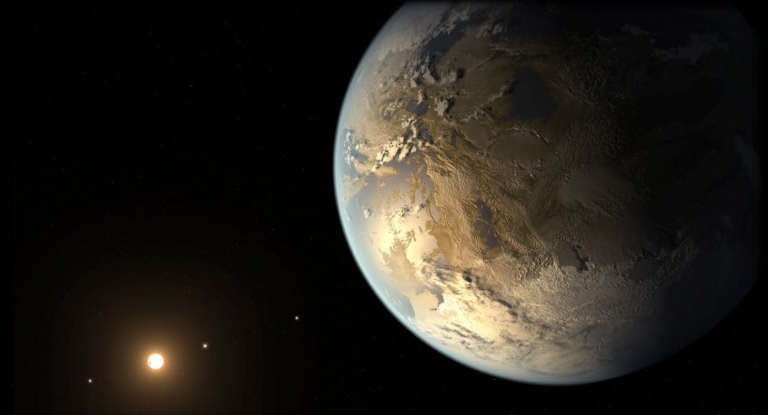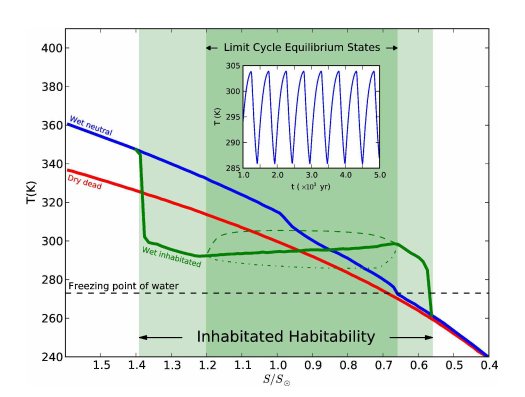Jaime Green • Jul 07, 2014
The Habitable Zone of Inhabited Planets
To at least some extent, the search for extrasolar planets is the search for extrasolar life. We don’t get excited about Earth-like planets because we’re worried our planet is lonely. We’re the ones looking to be less alone. Public interest piques at the mention of Earth-like discoveries: rocky worlds, roughly Earth’s size, in their star’s habitable zone. It seems simple. But of course, it’s not. Habitability is a very complicated thing, and if we want to search for real candidates for habitability, we have to delve more deeply into what habitability means—deeper than the headlines about the latest Earth-like find, for sure.
A team of Colombian researchers are arguing for a new refinement to the idea of the habitable zone that takes the presence of life itself into account. The habitable zone, or HZ, is the basic metric of habitability. It is the range of distances at which a planet can orbit its star and be at the right temperature to have liquid water on its surface.

The simplest conception of the habitable zone is based purely on insolation, or energy coming in from the star and heating the planet's surface. In this bare-bones definition, habitability is a simple function of the star’s luminosity and the planet’s distance from that sun. Here, we’re looking for planets that are not too hot and not too cold—there’s a reason it's called the Goldilocks zone.
Water alone doesn’t make a planet habitable, but even the presence of liquid water, even just that question of temperature, depends on more than just incoming stellar heat. Earth’s surface temperatures are influenced by atmosphere, cloudiness, weather patterns, ground cover, geothermal heat, the eccentricity of our orbit, and more. An exoplanet’s habitability would be similarly complicated, since all of these conditions affect how stellar energy translates to a planet's surface temperature.
In a study accepted for publication in the journal Biogeosciences, authors Jorge I. Zuluaga et al. write that yet another factor makes a strong enough impact on habitability that it should also be taken into account: life itself.
The authors make the case for splitting the standard idea of a habitable zone into two classifications. The first is the Abiotic Habitable Zone, or AHZ, which is basically the standard model I’ve previously discussed. The second is the Inhabited Habitable Zone, or InHZ, which takes life’s alterations on a planet into account. The idea is that life alters a planet’s habitability so much that the zone shifts closer or farther from a star; possibly both.
While standard HZ models see habitability as a product of abiotic (non-living) factors; Zuluaga et al. argue that habitability may be an emergent property of “a very complex system involving the interaction among astrophysical, geophysical, and not less important biological factors.” This paper doesn't set the terms of the InHZ; rather, it argues for its validity and necessity as a concept.
The logic here may seem paradoxical: Life makes a planet able to support life. But aside from the practical fact that a planet's habitability may change over time due to stellar or geophysical evolution, perhaps life can evolve under certain conditions and then contribute to climate stability. The authors propose a logical loophole: Abiotic habitability never asks how the water got there, just whether or not it is liquid. Likewise, inhabited habitability need not ask how the first life forms got there, just what their effects might be.
A single paper can't unravel all of these riddles, so Zuluaga et al. focus on one question in particular: Does inhabitation affect habitability? Their answer is yes. Life is a powerful enough force for environmental change that it must be taken into account alongside abiotic factors like the planet’s distance from a star and its orbital eccentricity. Encouragingly, for those of us feeling lonely in the cosmos, this study says the presence of life seems to expand the habitable zone.
The authors use several strategies to make their case. First, they show how powerfully life on Earth affects its environment, and that the feedback cycle works in both directions. Life's impact on cloud cover is one of their strongest examples. Clouds—composed of either water or carbon dioxide—can have a dramatic impact on habitability through the greenhouse effect and albedo. (Albedo is a measure of a surface’s reflectivity. High albedo surfaces reflect back much of the light and heat that hits them, while low albedo surfaces absorb energy. High albedo clouds keep a planet cool by reflecting, rather than absorbing, stellar energy.)
Research indicates that on Earth, plant life leads to more cloud cover. Likewise, airborne microorganisms in an exoplanet’s atmospheric layers could serve as seeds that trigger more cloud formation. The effect can be either cooling due to albedo, or warming thanks to the greenhouse effect. In either case, clouds or a lack thereof may alter habitability, nudging a planet’s temperature in one direction or another.
Life also can affect the carbon cycle. Plants on Earth affect the amount of CO2 in the air; calcareous plankton have been a major factor in changes to Earth's carbon cycle. These systems impact the heat-trapping properties of our atmosphere and the chemistry of the atmosphere and oceans.
There is also the dramatic impact that technologically advanced life—like us—can have on a planet’s livability. We may be in the process of nudging our own planet out of its habitable zone without altering its orbit an inch, thanks to carbon emissions. A planet-hunting alien might think Earth was prime habitable territory from what they could see from far away. However, we have the power to change that.
Examples from Earth’s biosphere aren’t the only way the authors make their case. After using our own planet to establish the premise, they use conceptual models to show how life could change the habitability of hypothetical planets.
Imagine a planet where life drives cloud formation during the day. This could be due to evapotranspiration—water vapor released by life—or tiny airborne lifeforms serving as nuclei, or seeds, around which clouds condense. It’s plausible that these cloud-generating mechanisms could be active during the day but not at night. In such a system, the skies would be cloudy during the day, and the clouds' high albedo could reflect more starlight out to space, keeping the planet cool. At night, the clouds clear, allowing heat to radiate into space and escape. Thus, the inhabited planet, with its atmospheric cycles driven by life, is overall kept much cooler than a planet with a steady cloud cover or one with clear skies. In this case, the cyclic nature of life (or rather life’s cyclical interactions with its environment) extends the HZ, in toward the star.
Another example from the paper uses a simplified model of inhabitation called Daisyworld. This model has been used in many variations and permutations since 1983 to show the dynamical interactions of a simplified inhabited world. The basic Daisyworld reduces the interactions of life with its environment to two kinds of organisms: white daisies and black daisies. These daisies either grow or die off in response to changes in surface temperature and growing space. Patches of white or black daisies have different albedos—as does bare ground—and thus impact the surface temperature as they grow or die.

The addition of a water cycle driven by the daisies provides insight into life’s effect on the HZ. In this case, surface temperature impacts the formation of clouds, which contribute along with the daisies to changes in the planet’s albedo. Zuluaga et al. compare three Daisyworld scenarios: dry and lifeless, wet and lifeless, and wet with inhabitation. In both lifeless scenarios, surface temperature tracks roughly with how close the planet is to its star (closer is warmer, more distant is cooler, just like you'd expect). But when daisies are present, the habitable zone becomes wider. The interactions of life and the environment keep the planet habitable at both higher and lower levels of insolation than the planet would be without the effects of life.
Of course, models are just models. Real biospheres are far more complex than a four-variable Daisyworld model. But currently, all of our definitions of habitability are based on models and speculation (at least until we touch down on alien soil—or alien barren rock—to make observations ourselves). In looking for Earth-like planets that might be home to life, we should be careful to keep our minds open to all possibilities, including that a planet might be habitable because life is there.
Let’s Go Beyond The Horizon
Every success in space exploration is the result of the community of space enthusiasts, like you, who believe it is important. You can help usher in the next great era of space exploration with your gift today.
Donate Today

 Explore Worlds
Explore Worlds Find Life
Find Life Defend Earth
Defend Earth

